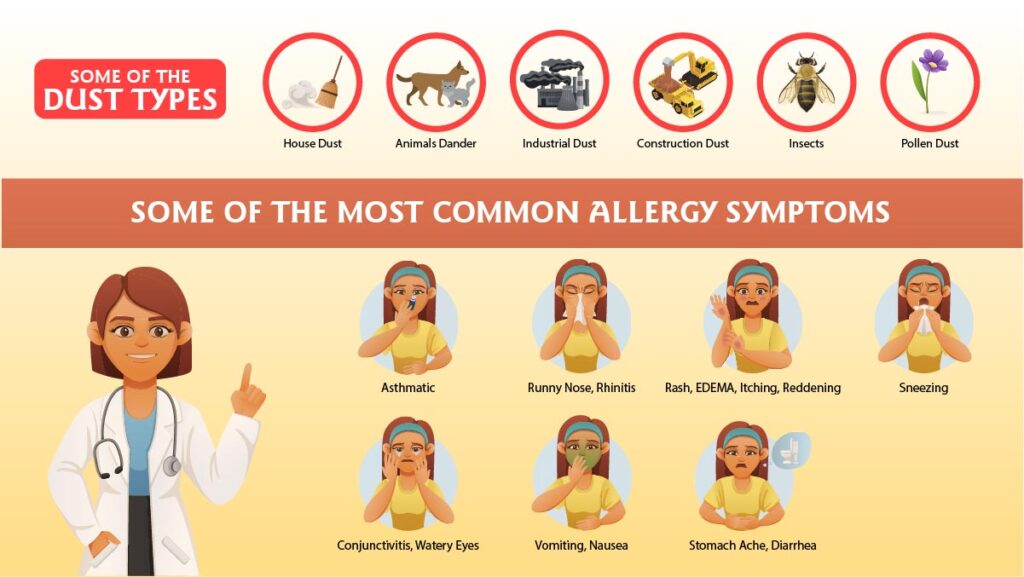Dust types originate from various sources and processes. Dust is a combination of tiny particles that can spread through the air because of different activities and environmental factors. Although it’s a common occurrence, we tend to overlook it in our daily routines. This article aims to shed light on the different types of dust and their harmful effects. Each dust type has distinct properties that can be harmful to both the environment and people’s health. So, it is necessary to know about different dust types.
Here are some examples of dust types:
This is a common dust found in homes and indoor spaces. It is a mixture of different particles such as dead skin cells, fibers, pet hair, dirt brought in from the outside.
- Pollen
Pollen dust is a fine, powdery substance that comes from flowers, trees, and other plants. Although it’s not always visible, it’s present all around us, especially during the spring and summer seasons. Some people may experience symptoms of allergies, such as itchy eyes and noses, as well as sneezing when they breathe in pollen dust. However, not everyone is affected by allergies, as it varies from person to person.
- House Dust Mites
These are tiny, microscopic mites that thrive in house dust. They feed on dead skin cells and have the potential to make certain individuals allergic.
Industrial activities can generate different types of dust depending on the materials being processed. For example, factories, construction sites and mining operations can generate industrial dust.
- Quartz Powder
This type of dust contains tiny silica particles, a mineral that is found in rocks and soil naturally. If breathed, it can be dangerous to your health and cause breathing problems like silicosis.
- Coal Dust
Coal dust is generated during coal mining, transportation and combustion. Inhaling coal dirt can be dangerous to the respiratory tract.
- Wood Dust/Saw Dust
Wood dust is generated during woodworking and the processing of wood-based materials. It can also cause breathing difficulties, especially in poorly ventilated areas.
- Agricultural Dust
Agricultural activities such as ploughing, harvesting, and tillage can generate agricultural dust, including soil particles and other agricultural materials.
Volcanic ash enters the atmosphere after volcanic eruptions. This fine ash can travel long distances, affecting air quality, causing health hazards and affecting weather.
- Desert Dust
Wind erosion in arid regions can cause desert dust storms, carrying dust particles over a wide area and even to other continents.
- Soot
Soot is a black, powdery substance produced by incomplete combustion of carbonaceous materials. It is commonly found in exhaust fumes and can contribute to air pollution.
- Ash
Ash dust is fine, powdery particles created when something burns, like wood, charcoal or paper. It can also result from volcanic eruptions. Ash dust can travel in the air, affecting air quality.
- Construction Dust
This type of dust is generated during construction operations such as material cutting, grinding and demolition. Older buildings can contain various particles such as silica and asbestos.
- Road Dust
Road dust is formed from the combination of traffic and road wear. It consists of small particles of dirt and debris that accumulate on roads. These particles can be from various sources including vehicles, soil and leaves. Road dust can make roads dirty and may also have an impact on air quality.
- Cigarette Smoke
Tobacco smoke contains various harmful particles and chemicals. Tobacco smoke includes a variety of noxious particles and compounds. This smoke can create health concerns for smokers as well as non-smokers who are exposed to smokers.
- Space Dust
Tiny particles floating in outer space, known as cosmic dust, are composed of remains from star debris and interstellar matter. These specks of dust often travel through the universe, originating from stars or asteroids.
- Micro Plastic
These are very small plastic particles, often invisible to the naked eye, that form when large plastic parts break.
- Bacterial and Fungal Spores
These are small reproductive units released by certain bacteria and fungi. Indoors, it can lead to mold growth and affect air quality.
- Mold Spores
Mold spores are released by mold colonies, become airborne and can cause respiratory illness and allergic reactions if inhaled.
Understanding the origins of dust types is crucial for assessing their impact on air quality, human health and the environment. Efforts to control and mitigate dust often focus on managing its sources and reducing its dispersion.

